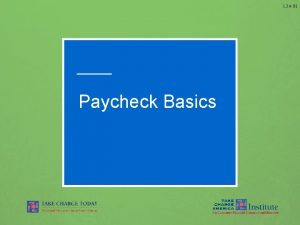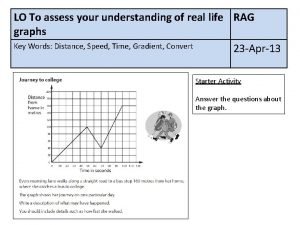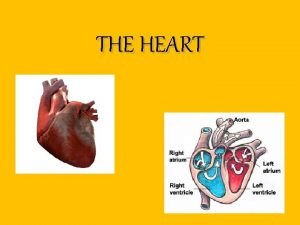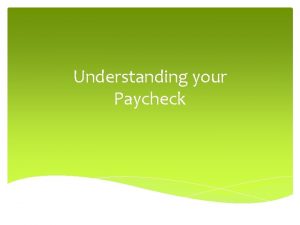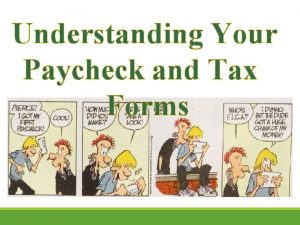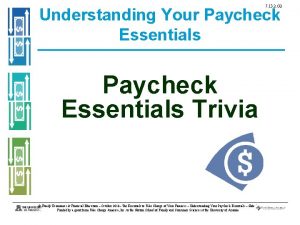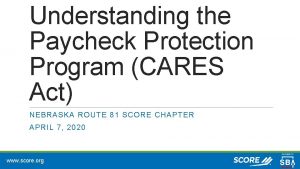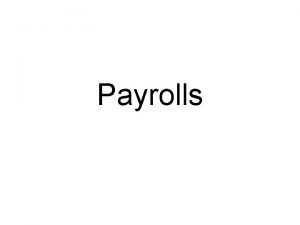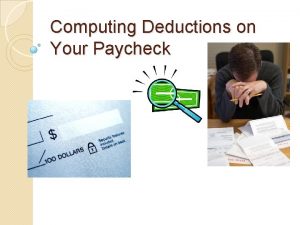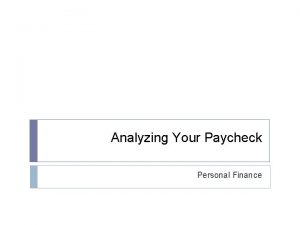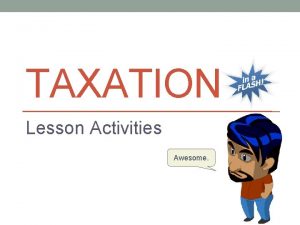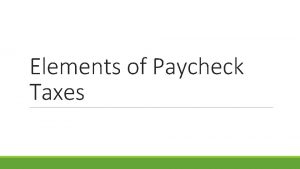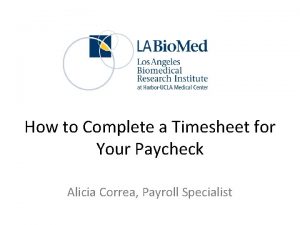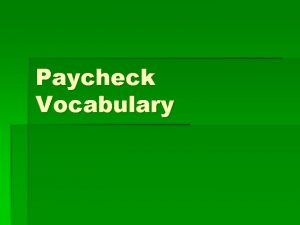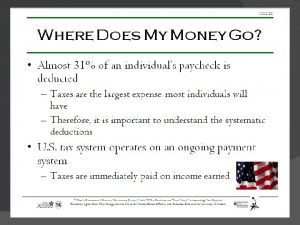1 13 1 G 1 Understanding Your Paycheck






























- Slides: 30

1. 13. 1. G 1 Understanding Your Paycheck and Tax Forms © Family Economics & Financial Education – Revised September 2006 – Paychecks and Taxes Unit – Understanding Your Paycheck and Tax Forms Funded by a grant from Take Charge America, Inc. to the Norton School of Family and Consumer Sciences at the University of Arizona

1. 13. 1. G 1 Where Does My Money Go? • Almost 31% of an individual’s paycheck is deducted • U. S. tax system operates on an ongoing payment system – Taxes are immediately paid on income earned © Family Economics & Financial Education – Revised September 2006 – Paychecks and Taxes Unit – Understanding Your Paycheck and Tax Forms Funded by a grant from Take Charge America, Inc. to the Norton School of Family and Consumer Sciences at the University of Arizona

1. 13. 1. G 1 Paying Employees Three methods employers may use to pay employees: 1. Paycheck • • • Most common method Employee responsible for handling the paycheck Immediately see payroll stub and deductions © Family Economics & Financial Education – Revised September 2006 – Paychecks and Taxes Unit – Understanding Your Paycheck and Tax Forms Funded by a grant from Take Charge America, Inc. to the Norton School of Family and Consumer Sciences at the University of Arizona

1. 13. 1. G 1 Paying Employees continued 2. Direct Deposit • • Employers directly deposit employee’s paycheck into the authorized employee’s bank account Employee receives the paycheck stub detailing the paycheck deductions Most secure because there is no direct handling of the check Employee knows exactly when paycheck will be deposited and available © Family Economics & Financial Education – Revised September 2006 – Paychecks and Taxes Unit – Understanding Your Paycheck and Tax Forms Funded by a grant from Take Charge America, Inc. to the Norton School of Family and Consumer Sciences at the University of Arizona

1. 13. 1. G 1 Paying Employees continued 3. Payroll Card • • A payroll card electronically carries the balance of the employee’s net pay Funds are directly deposited by an employer into an account at a financial institution that is linked to the payroll card – Parties involved: » Employer » Employee » Financial institution • Use the payroll card for ATM withdrawals or to make purchases © Family Economics & Financial Education – Revised September 2006 – Paychecks and Taxes Unit – Understanding Your Paycheck and Tax Forms Funded by a grant from Take Charge America, Inc. to the Norton School of Family and Consumer Sciences at the University of Arizona

1. 13. 1. G 1 Payroll Card • There are numerous fees associated with payroll cards – Number of fees depends upon the financial institution – Examples: • • Monthly or annual fee ATM fee Inactivity fee Fee after a specific number of transactions have been used Replacement fee if the card is lost, stolen , or destroyed Load fee (when funds are placed on the card account) Point of sale (POS) fee for using the card at a POS terminal, or an electronic payment processor © Family Economics & Financial Education – Revised September 2006 – Paychecks and Taxes Unit – Understanding Your Paycheck and Tax Forms Funded by a grant from Take Charge America, Inc. to the Norton School of Family and Consumer Sciences at the University of Arizona

1. 13. 1. G 1 Benefits of Using Payroll Cards • Employers – Lower internal costs • Employees – Safer than carrying large amounts of cash – Unbanked employees do not have to pay check cashing fees • Americans roughly spend $8 billion annually in check cashing fees © Family Economics & Financial Education – Revised September 2006 – Paychecks and Taxes Unit – Understanding Your Paycheck and Tax Forms Funded by a grant from Take Charge America, Inc. to the Norton School of Family and Consumer Sciences at the University of Arizona

1. 13. 1. G 1 Progressive vs. Regressive Taxes • Taxes – Compulsory charges imposed on citizens by local, state, and federal governments – Used to provide public goods and services – Largest amount of taxes a person pays is on his/her income • Progressive Taxes – Take a larger percentage of income from high income taxpayers – Examples are State and Federal taxes • Regressive Taxes – As income rises, the taxes remain the same or decrease – Higher income taxpayers are proportionally charged less © Family Economics & Financial Education – Revised September 2006 – Paychecks and Taxes Unit – Understanding Your Paycheck and Tax Forms Funded by a grant from Take Charge America, Inc. to the Norton School of Family and Consumer Sciences at the University of Arizona

1. 13. 1. G 1 Taxes continued • Internal Revenue Service (IRS) – Collects federal taxes, issues regulations, and enforces tax laws written by the United States Congress © Family Economics & Financial Education – Revised September 2006 – Paychecks and Taxes Unit – Understanding Your Paycheck and Tax Forms Funded by a grant from Take Charge America, Inc. to the Norton School of Family and Consumer Sciences at the University of Arizona

1. 13. 1. G 1 Starting a New Job To receive a paycheck, an employee must: – Complete a Form W-4 • Employee’s Withholding Allowance Certificate – Complete a Form I-9 • Employment Eligibility Verification © Family Economics & Financial Education – Revised September 2006 – Paychecks and Taxes Unit – Understanding Your Paycheck and Tax Forms Funded by a grant from Take Charge America, Inc. to the Norton School of Family and Consumer Sciences at the University of Arizona

1. 13. 1. G 1 Form W-4 Employee’s Withholding Allowance Certificate – Determines the percentage of gross pay which will be withheld for taxes • Allowances – Used to determine the amount of federal taxes withheld from the paycheck – A person may claim a personal allowance if no one else claims the person as a dependent • Dependent – a person who relies on the taxpayer for financial support © Family Economics & Financial Education – Revised September 2006 – Paychecks and Taxes Unit – Understanding Your Paycheck and Tax Forms Funded by a grant from Take Charge America, Inc. to the Norton School of Family and Consumer Sciences at the University of Arizona

1. 13. 1. G 1 Form I-9 Employment Eligibility Verification Form • Used to verify the eligibility of individuals to avoid hiring undocumented workers or others who are not eligible to work in the United States • Must provide documentation which establishes identity and employment eligibility – Examples include driver’s license, passport, Social Security card, and birth certificate © Family Economics & Financial Education – Revised September 2006 – Paychecks and Taxes Unit – Understanding Your Paycheck and Tax Forms Funded by a grant from Take Charge America, Inc. to the Norton School of Family and Consumer Sciences at the University of Arizona

1. 13. 1. G 1 Form W-2 Wage and Tax Statement • States the amount of money earned and taxes paid throughout the previous year • Used to file income taxes • By January 31, an employer should mail a Form W-2 to each employee for the previous year © Family Economics & Financial Education – Revised September 2006 – Paychecks and Taxes Unit – Understanding Your Paycheck and Tax Forms Funded by a grant from Take Charge America, Inc. to the Norton School of Family and Consumer Sciences at the University of Arizona

1. 13. 1. G 1 Minimum wage • The lowest hourly rate an employer may legally pay most workers. – OH = $7. 95/hour ($3. 98 for tipped employees) – Updated in Jan. every year as the state sees a need. Sub minimum wage can be applied to fulltime students, employees who are younger than 20, and employees who are developmentally disabled © Family Economics & Financial Education – Revised September 2006 – Paychecks and Taxes Unit – Understanding Your Paycheck and Tax Forms Funded by a grant from Take Charge America, Inc. to the Norton School of Family and Consumer Sciences at the University of Arizona

1. 13. 1. G 1 Reading a Paycheck © Family Economics & Financial Education – Revised September 2006 – Paychecks and Taxes Unit – Understanding Your Paycheck and Tax Forms Funded by a grant from Take Charge America, Inc. to the Norton School of Family and Consumer Sciences at the University of Arizona

1. 13. 1. G 1 Paycheck Stub On-The-Go Employee SSN Check # Beakens, Joe 201 -92 -4856 164 Check Amount $1, 102. 98 Employee Address 293 Michael Grove Billings, MT 59102 Pay Type. Gross Pay Deductions Current Year-to-date $1, 353. 33 Federal Withholding State Withholding Fed OASDI/EE or Social Security Fed MED/EE or Medicare Medical 401 K $106. 00 $40. 82 $83. 91 $19. 62 $0. 00 $503. 46 $117. 72 $636. 00 $244. 92 $0. 00 Totals $250. 35 $1, 502. 10 Pay Period 6/11/2004 -7/11/2004 Paycheck Stub – A document included each pay period which outlines paycheck deductions © Family Economics & Financial Education – Revised September 2006 – Paychecks and Taxes Unit – Understanding Your Paycheck and Tax Forms Funded by a grant from Take Charge America, Inc. to the Norton School of Family and Consumer Sciences at the University of Arizona

1. 13. 1. G 1 Personal Information – States the employee’s full name, address, and social security number – Always check to ensure this information is correct © Family Economics & Financial Education – Revised September 2006 – Paychecks and Taxes Unit – Understanding Your Paycheck and Tax Forms Funded by a grant from Take Charge America, Inc. to the Norton School of Family and Consumer Sciences at the University of Arizona

1. 13. 1. G 1 Pay Period – The length of time for which an employee’s wages are calculated; most are weekly, bi-weekly, twice a month, or monthly © Family Economics & Financial Education – Revised September 2006 – Paychecks and Taxes Unit – Understanding Your Paycheck and Tax Forms Funded by a grant from Take Charge America, Inc. to the Norton School of Family and Consumer Sciences at the University of Arizona

1. 13. 1. G 1 Gross Pay – The total amount of money earned during a pay period before deductions • This is calculated by multiplying the number of hours worked by the hourly rate • If a person is on salary, it is the total salary amount divided by the specified time period © Family Economics & Financial Education – Revised September 2006 – Paychecks and Taxes Unit – Understanding Your Paycheck and Tax Forms Funded by a grant from Take Charge America, Inc. to the Norton School of Family and Consumer Sciences at the University of Arizona

1. 13. 1. G 1 Net Pay – The amount of money left after all deductions have been withheld from the gross pay earned in the pay period © Family Economics & Financial Education – Revised September 2006 – Paychecks and Taxes Unit – Understanding Your Paycheck and Tax Forms Funded by a grant from Take Charge America, Inc. to the Norton School of Family and Consumer Sciences at the University of Arizona

1. 13. 1. G 1 Deductions – The amount of money subtracted from the gross pay earned for mandatory systematic taxes, employee sponsored medical benefits, and/or retirement benefits © Family Economics & Financial Education – Revised September 2006 – Paychecks and Taxes Unit – Understanding Your Paycheck and Tax Forms Funded by a grant from Take Charge America, Inc. to the Norton School of Family and Consumer Sciences at the University of Arizona

1. 13. 1. G 1 Federal Withholding Tax – The amount required by law for employers to withhold from earned wages to pay taxes – The amount of money deducted depends on the amount earned and information provided on the Form W-4 © Familydeduction Economics & Financial withheld Education – Revised September – Paychecks and Taxes Unit – Understanding Paycheck and Tax Forms – Largest from 2006 an employee’s gross. Yourincome Funded by a grant from Take Charge America, Inc. to the Norton School of Family and Consumer Sciences at the University of Arizona

1. 13. 1. G 1 State Withholding Tax – The percentage deducted from an individual’s paycheck to assist in funding government agencies within the state – The percentage deducted depends on the amount of gross pay earned © Family Economics & Financial Education – Revised September 2006 – Paychecks and Taxes Unit – Understanding Your Paycheck and Tax Forms Funded by a grant from Take Charge America, Inc. to the Norton School of Family and Consumer Sciences at the University of Arizona

1. 13. 1. G 1 FICA (Federal Insurance Contribution Act) FICA – This tax includes two separate taxes: Fed OASDI/EE or Social Security and Fed MED/EE or Medicare – These two taxes can be combined as one line item or itemized separately on a paycheck stub © Family Economics & Financial Education – Revised September 2006 – Paychecks and Taxes Unit – Understanding Your Paycheck and Tax Forms Funded by a grant from Take Charge America, Inc. to the Norton School of Family and Consumer Sciences at the University of Arizona

1. 13. 1. G 1 Social Security – Nation’s retirement program, helps provide retirement income for elderly and pays disability benefits – Based upon a percentage (6. 2%) of gross income, employer matches the contribution made by the employee © Family Economics & Financial Education – Revised September 2006 – Paychecks and Taxes Unit – Understanding Your Paycheck and Tax Forms Funded by a grant from Take Charge America, Inc. to the Norton School of Family and Consumer Sciences at the University of Arizona

1. 13. 1. G 1 Medicare – Nation’s health care program for the elderly and disabled, provides hospital and medical insurance to those who qualify – Based upon a percentage (1. 45%) of gross income © Family Economics & Financial Education – Revised September 2006 – Paychecks and Taxes Unit – Understanding Your Paycheck and Tax Forms Funded by a grant from Take Charge America, Inc. to the Norton School of Family and Consumer Sciences at the University of Arizona

1. 13. 1. G 1 Medical – The amount taken from the employee’s paycheck for medical benefits – Occurs when the employer has a medical plan for employees but does not pay full coverage for his/her benefits © Family Economics & Financial Education – Revised September 2006 – Paychecks and Taxes Unit – Understanding Your Paycheck and Tax Forms Funded by a grant from Take Charge America, Inc. to the Norton School of Family and Consumer Sciences at the University of Arizona

1. 13. 1. G 1 Retirement Plan – The amount an employee contributes each pay period to a retirement plan – A specified percentage of the contribution is often matched by the employer – May be a 401 K, a state, or local retirement plan © Family Economics & Financial Education – Revised September 2006 – Paychecks and Taxes Unit – Understanding Your Paycheck and Tax Forms Funded by a grant from Take Charge America, Inc. to the Norton School of Family and Consumer Sciences at the University of Arizona

1. 13. 1. G 1 Year-to-Date • Total of all of the deductions which have been withheld from an individual’s paycheck from January 1 to the last day of the pay period indicated on the paycheck stub © Family Economics & Financial Education – Revised September 2006 – Paychecks and Taxes Unit – Understanding Your Paycheck and Tax Forms Funded by a grant from Take Charge America, Inc. to the Norton School of Family and Consumer Sciences at the University of Arizona

1. 13. 1. G 1 • http: //www. paycheckcity. com/calculator/ho urly/result © Family Economics & Financial Education – Revised September 2006 – Paychecks and Taxes Unit – Understanding Your Paycheck and Tax Forms Funded by a grant from Take Charge America, Inc. to the Norton School of Family and Consumer Sciences at the University of Arizona
 Paycheck
Paycheck Paycheck basics
Paycheck basics How much does wanda earn per hour
How much does wanda earn per hour Paycheck
Paycheck 3 benefits of paying taxes
3 benefits of paying taxes Trina's paycheck earnings varies
Trina's paycheck earnings varies Give us your hungry your tired your poor
Give us your hungry your tired your poor Understanding your stakeholders
Understanding your stakeholders Trust in the lord lean not on your own understanding song
Trust in the lord lean not on your own understanding song The ability to locate interpret and apply information
The ability to locate interpret and apply information Chapter 1 understanding your health and wellness
Chapter 1 understanding your health and wellness Chapter 1 understanding your health and wellness
Chapter 1 understanding your health and wellness Lean not on your own understanding
Lean not on your own understanding Understanding health and wellness
Understanding health and wellness Let's check your understanding
Let's check your understanding Understanding your business finances
Understanding your business finances Understanding your digital footprint
Understanding your digital footprint Chapter 1 health and wellness fundamentals
Chapter 1 health and wellness fundamentals Miymaths
Miymaths Understanding your intuition
Understanding your intuition Distance time graph activity
Distance time graph activity Coping with gay loneliness
Coping with gay loneliness Stop blaming your parents for your problems
Stop blaming your parents for your problems Is your heart in the middle of your chest
Is your heart in the middle of your chest Pencil poem for child
Pencil poem for child How to introduce yourself to classmates
How to introduce yourself to classmates Wear your heart on your sleeve idiom meaning
Wear your heart on your sleeve idiom meaning Answer the questions.write in your notebook
Answer the questions.write in your notebook In your notebook define the following
In your notebook define the following Enagic compensation plan
Enagic compensation plan Your conscious awareness of your own name and self identity
Your conscious awareness of your own name and self identity

